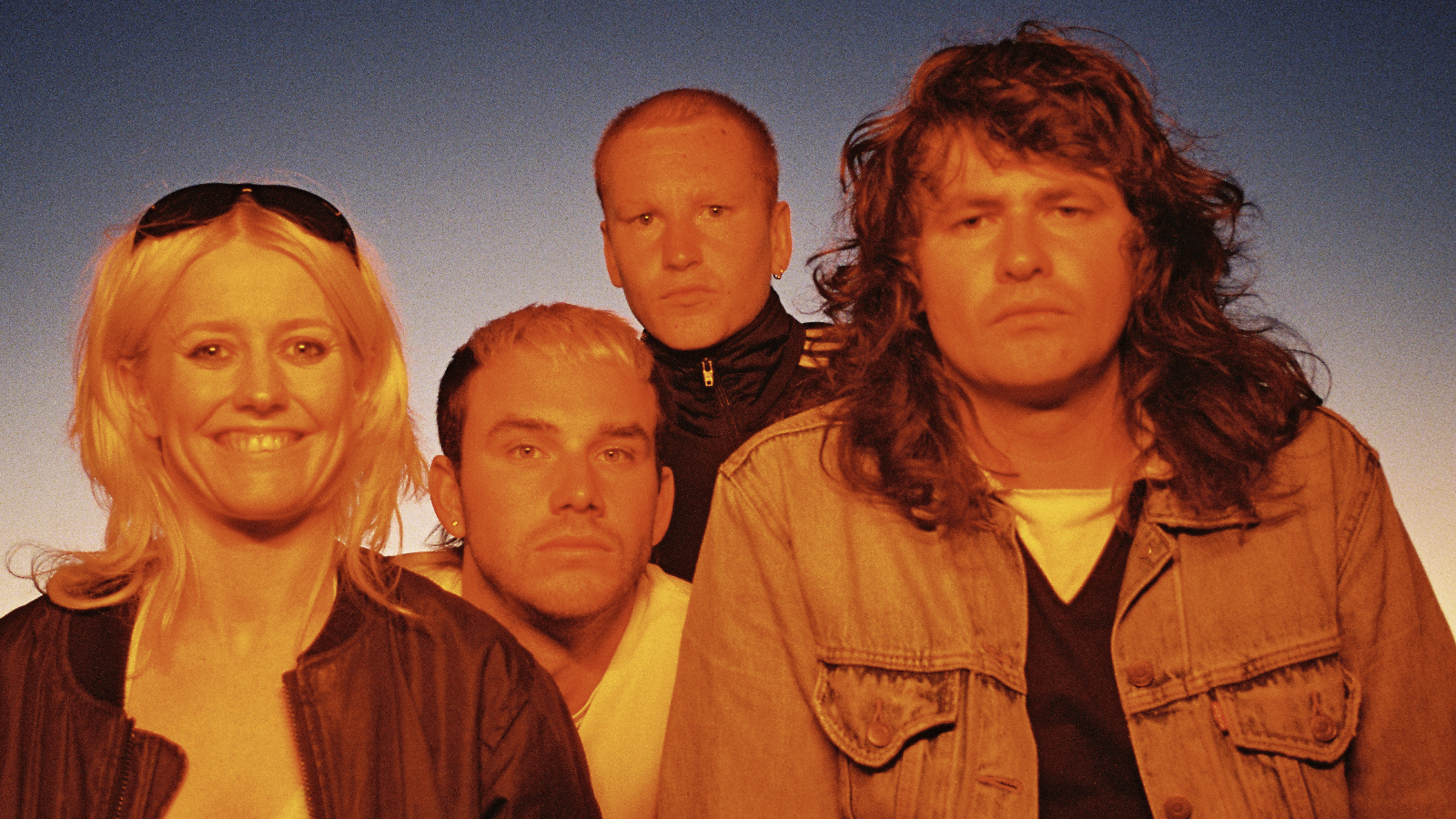Amyl And The Sniffers’ Dec Martens and Gus Romer: “If we’re eating the same foods and sharing the same bathroom, we end up making music naturally”
On their explosive second album, Amyl And The Sniffers expand on their raw ’n’ ravenous brand of distinctly Australian punk-rock

It was just five years ago when Amyl And The Sniffers (a play on the name of frontwoman Amy Taylor, and an underground sex shop owner’s drug of choice) first burst to life. The quartet wrote, recorded and laid their seal of approval on their debut EP, 2016’s Giddy Up, in a jaw-dropping twelve hours. They’d bump up the timeframe to a few weeks for its follow-up, 2017’s Big Attraction, and further to a few months for their eponymous 2018 full-length. Comparatively, their latest record – the punchy and polychromatic Comfort To Me – may as well have taken them a lifetime.
Work on the new LP started shortly after Taylor and co. wrapped up the touring cycle for their ’18 debut, riding the high of a record that not only broke them out on the touring circuit as a force to be reckoned with, but went on to win the prestigious ARIA for Best Rock Album. But what should’ve been blue skies and a clear road ahead quickly turned into a stormy labyrinth of potholes. 2019’s summer brought the bushfires that devastated Australia, followed shortly thereafter with the onset of the ongoing COVID-19 pandemic.
Amyl And The Sniffers had their world turned upside down in an instant – from a future that offered world touring and lucrative studio opps, to months crammed into their three-bedroom sharehouse. Pieced together between that haunt and a storage unit down the road from it, Comfort To Me ended up being the band’s most closely knit body of work thus far. It’s sprawling and experimental, yet notably insular. And as shredder Dec Martens and bassist Gus Romer told Australian Guitar, it was a distinctly lowkey effort.
How did you want this record to best encapsulate the spirit and ethos of what Amyl And The Sniffers is in 2021?
Romer: I think we were definitely in a different kind of headspace [while recording it], but it wasn’t as though we had a conscious thought process to do anything differently, or approach anything in a different way. The way we go about things is that it’s all of us writing music together, and then whatever comes from that is what comes from that, and that’s the final product.
If there’s one thing we’ve learned from Amyl over the years, it’s that it pays to go with the flow.
Romer: Yeah, totally. We don’t put a great deal of thought into it. It’s not something we converse about regularly, and there’s no master plan. We’re never trying to do anything in particular, it just kind like… Whatever happens is what happens, and that’s what it is.
So this record came together between two distinct locations, being your Melbourne sharehouse and a storage unit down the road from it. Do you reckon that insularity comes across in the record itself?
Martens: I don’t know, I think after being on the road for two, three years, and living together as well, I guess we’re already so close that there’s a bit of a unified feel to it by default. We gel really well together. I think that’s probably what Gus was getting at with there not being much conversation or thought put into what we do – we get it all done that way because that’s just how we live.
It’s like musical telekinesis, right?
Martens: Yeah, exactly. Y’know, if we’re eating the same foods and sharing the same bathroom, then we end up making music naturally.
Get The Pick Newsletter
All the latest guitar news, interviews, lessons, reviews, deals and more, direct to your inbox!
What guitars were you jamming out on for this record?
Martens: I used my Stratocaster, it’s got Seymour Duncan Hot Rails in it so it’s got a bit more juice to it. And then on some tracks I used an SG, but I’m not exactly sure what type of SG it was. And then I used a Tele as well.
Do you have a favourite axe, or one that you tend to gravitate towards?
Martens: Yeah, so that Strat has been my main guitar since the beginning of 2018. I think it’ll always be my live guitar. I’ve got a newer Strat that I use as a backup, but it’s just like... It’s nothing compared to the way that other Strat feels. I love playing that one.
Did you put those Hot Rails in yourself?
Martens: Yeah – when I first put them in, I didn’t really know much about pickups or anything. I remember I was talking to a mate that I used to play in a band with and I was like, “I want the power of a Gibson, but in my Strat.” And funnily enough, people had been saying that for years, so he told me about single-coil-sized humbuckers. He had one kicking around so he sold it to me, I put it in my guitar and I was just like, “F*** yeah, this is powerful!”
But if you already have the SG, why not just pull the Gibson tone from that?
Martens: I guess being the sole guitarist in the band, you’ve gotta mix tones for your rhythm and lead. The lead is a lot better on a Strat because of its built-in tone and the way that it plays. So yeah, I figured that it just seemed seemed simpler. Plus, I already owned the Strat and I did own an SG at the time, so it made more sense to put that juice into the Strat than to get an SG that sings a bit more.
I love that really buzzy, almost sort of synth-y tone on “Hertz” – how did you get that?
Martens: It must have been with the Strat. I think what we aimed for was just a bit less gain than I normally have. I started experimenting with different setups – I wired up the bridge so that I could have the bridge pickup as a single-coil as well. So I think for some of the softer songs, like “Knifey” too, I experimented a little bit more with the single-coil.
Do you guys have the stage in mind when you’re writing?
Romer: Not at all. Well not me, personally. Like I said before, there’s no thought process that goes into it, and nothing gets considered by any means. We’re just making music that sounds good to us.
So how does that translate to the studio, then? Are you all jamming live in the room?
Martens: Yeah, so what we do is we rehearse the songs so that we’ve gotten them really tight in the writing process, and then for this album we went into like the demo process with Dan [Luscombe, producer], and that’s when we made a few minor adjustments to the structures. But pretty much when we’re playing the songs in that first stage, we’re rehearsing them so we have them absolutely down-pat, so that in an ideal situation, we can get them down live in the first take.
We do the drums and bass at the same time with guitar, and depending on whether we need vocal cues, we’ll do the vocals as scratch. So all the bass and drums are done live in a room with me playing along, and then the guitars get overdubbed.

Ellie Robinson is an Australian writer, editor and dog enthusiast with a keen ear for pop-rock and a keen tongue for actual Pop Rocks. Her bylines include music rag staples like NME, BLUNT, Mixdown and, of course, Australian Guitar (where she also serves as Editor-at-Large), but also less expected fare like TV Soap and Snowboarding Australia. Her go-to guitar is a Fender Player Tele, which, controversially, she only picked up after she'd joined the team at Australian Guitar. Before then, Ellie was a keyboardist – thankfully, the AG crew helped her see the light…
“Such a rare piece”: Dave Navarro has chosen the guitar he’s using to record his first post-Jane’s Addiction material – and it’s a historic build
“The best guitar player I ever heard”: Nashville guitar extraordinaire Mac Gayden – who worked with Bob Dylan, Elvis, Linda Ronstadt and Simon & Garfunkel – dies at 83




![[from left] George Harrison with his Gretsch Country Gentleman, Norman Harris of Norman's Rare Guitars holds a gold-top Les Paul, John Fogerty with his legendary 1969 Rickenbacker](https://cdn.mos.cms.futurecdn.net/TuH3nuhn9etqjdn5sy4ntW.jpg)





